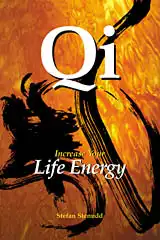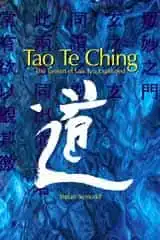|
Tao Te Ching
THE TAOISM OF LAO TZU
|
Tao Te Ching
|
The Book
The Taoism of Lao Tzu Explained. The great Taoist philosophy classic by Lao Tzu translated, and each of the 81 chapters extensively commented. Click the image to see the book at Amazon (paid link). |
Nameless Simplicity
Tao Te Ching is traditionally divided into two parts. One is called Tao, the Way, simply because its first chapter begins with that word, and the other is called Te, virtue, because that's the word its first chapter begins with. This, the 37th chapter of the book, is the last of the first part.
In the two manuscripts found in Mawangdui, dating to around the year 200 BC, the two parts have the opposite order. There, the whole book ends with this chapter – quite suitably with the words about the stillness in which the world settles by itself.
In spite of the Mawangdui manuscripts, I present the book in its traditionally established order. Otherwise it would get complicated for the reader to compare different versions of the text. Also, it's the path taken by most experts on this classic.
Myself, I find that the first chapter defining Tao, and the last one stating the purpose of the noble man's Tao, make perfect sense as the beginning and the end of the book. So, in spite of the Mawangdui manuscripts, I am inclined to trust the traditional order of the chapters more.
Simplicity
As for the word `simplicity' used in this chapter, its pictogram is the one for the uncarved wood, which is an image of utter simplicity that Lao Tzu favors in the book. He has used it several times before this chapter.This image presents simplicity as a rough and unrefined state of affairs, a natural form before altered by cultural or other ambitions. Things as they are before human intervention.
When Lao Tzu also calls it nameless, he hints on its close relation to Tao, the Way, since namelessness is one of its traits. This was pointed out already in the first chapter, which states that the way that can be walked is not the real Way, and the name that can be named is not the real name of it.
The uncarved wood lacking a name is similar to Tao, in the sense of being beyond description. The simplicity that can free all things of desire is not just any simplicity, but that of Tao, the simple truth behind all.
Tao needs not act, since its law decides how everything else has to act. If rulers abide, they follow the same law instead of fighting it. Then things will happen by themselves and the turn of events will be natural, according to the terms of the universe. Things move on as they should.
Desire
The word desire is used in 15 of the 81 chapters of the Tao Te Ching (chapters 1, 3, 15, 19, 29, 34, 36, 37, 39, 46, 57, 61, 64, 66, 77). The Chinese word, yu, isn't directed just at sexual desires, but at any kinds of longings, wants, lusts, and wishes.Lao Tzu doesn't really ban it, but he is clear about the benefit of being free of it. Desire is part of the human character, and therefore hard to avoid. There is no point in trying to suppress it completely, but those who follow Tao will find a way to make it dissolve.
In the sage, it no longer decides what action to take.
Desire is what risks interfering with the natural process, this chapter tells us. Greed is a kind of desire. So is hunger for power, and that for making a mark in history. When people interfere with the natural chain of events, they want to change them into more personally profitable outcomes. That disturbs the order of all. It has no chance of succeeding, but it can cause a lot of damage before failing.
Personal desire is as easy to understand as it is likely to appear, especially with people who have the power to make them imagine that they can fulfill it. We all want to make the most of our lives. If that means countering the natural cause of things, then we will make a lot of noise, cause a lot of trouble, but at the end we will find that we accomplished nothing durable.
We do better to accept things as they are, and find our place inside these patterns. There is a good place to be found for everyone, without upsetting the harmony. Actually, only by joining with the harmony are we ever likely to find that place.
NEXT
Tao Te Ching Explained
Preface
Introduction
Literature
translated and explained by Stefan Stenudd.
1 |
2 |
3 |
4 |
5 |
6 |
7 |
8 |
9 |
10 |
11 |
12 |
13 |
14 |
15 |
16 |
17 |
18 |
19 |
20 |
21 |
22 |
23 |
24 |
25 |
26 |
27 |
28 |
29 |
30 |
31 |
32 |
33 |
34 |
35 |
36 |
37 |
38 |
39 |
40 |
41 |
42 |
43 |
44 |
45 |
46 |
47 |
48 |
49 |
50 |
51 |
52 |
53 |
54 |
55 |
56 |
57 |
58 |
59 |
60 |
61 |
62 |
63 |
64 |
65 |
66 |
67 |
68 |
69 |
70 |
71 |
72 |
73 |
74 |
75 |
76 |
77 |
78 |
79 |
80 |
81 |
Tao Te Ching Explained
James Legge's Tao Te Ching
Aleister Crowley's Tao Te Ching
The 1st Chapter of Tao Te Ching in 76 Versions
Lao Tzu — Legendary Author of Tao Te Ching
My Taoism BooksClick the image to see the book at Amazon (paid link).
The Taoism of Lao Tzu Explained. The great Taoist philosophy classic by Lao Tzu translated, and each of the 81 chapters extensively commented. |
About Cookies
My Other Websites:
I Ching Online
The 64 hexagrams of the Chinese classic I Ching and what they mean in divination. Try it online for free.
Qi Energy Exercises
The ancient Chinese life energy qi (chi) explained, with simple instructions on how to exercise it.
Life Energy
The many ancient and modern life force beliefs all over the world explained and compared.
Taoismen på svenska
Other Books by Stefan Stenudd
Click the image to see the book at Amazon (paid link).
 Cosmos of the Ancients
Cosmos of the Ancients
The Greek philosophers and what they thought about cosmology, myth, and the gods.
 Qi — Increase Your Life Energy
Qi — Increase Your Life Energy
The life energy qi (also chi or ki) explained, with exercises on how to awaken, increase and use it.
 Aikido Principles
Aikido Principles
Basic concepts of the peaceful martial art. Aikido principles, philosophy, and fundamental ideas.
 Life Energy Encyclopedia
Life Energy Encyclopedia
Qi, prana, spirit, ruach, pneuma, and many other life forces around the world explained and compared.
 Archetypes of Mythology
Archetypes of Mythology
Jungian theories on myth and religion examined, from Carl G. Jung to Jordan B. Peterson.
 Stefan Stenudd
Stefan Stenudd
About me
I'm a Swedish author and aikido instructor. In addition to fiction, I've written books about Taoism and other East Asian traditions. I'm also an historian of ideas, researching ancient thought and mythology. Click the image to get to my personal website.Contact

 Tao Te Ching
Tao Te Ching Tao Quotes
Tao Quotes Fake Lao Tzu Quotes
Fake Lao Tzu Quotes